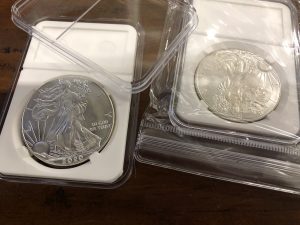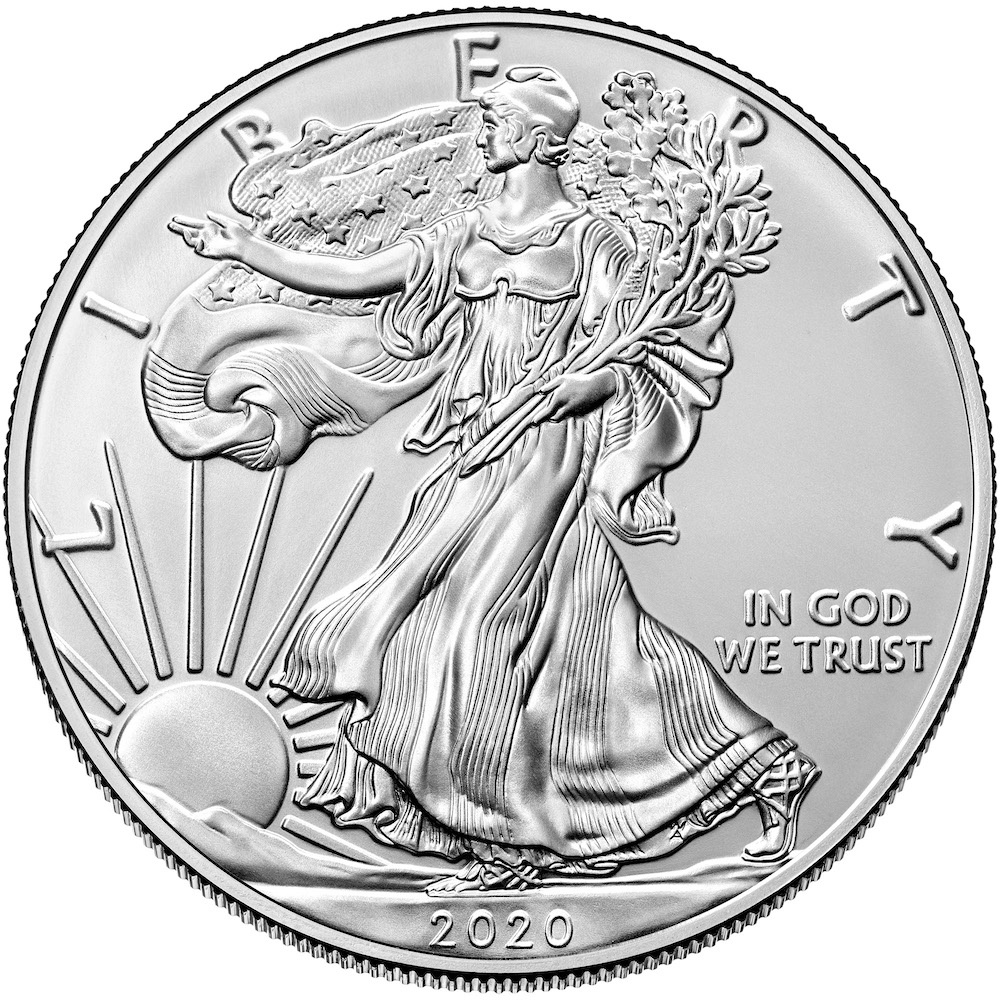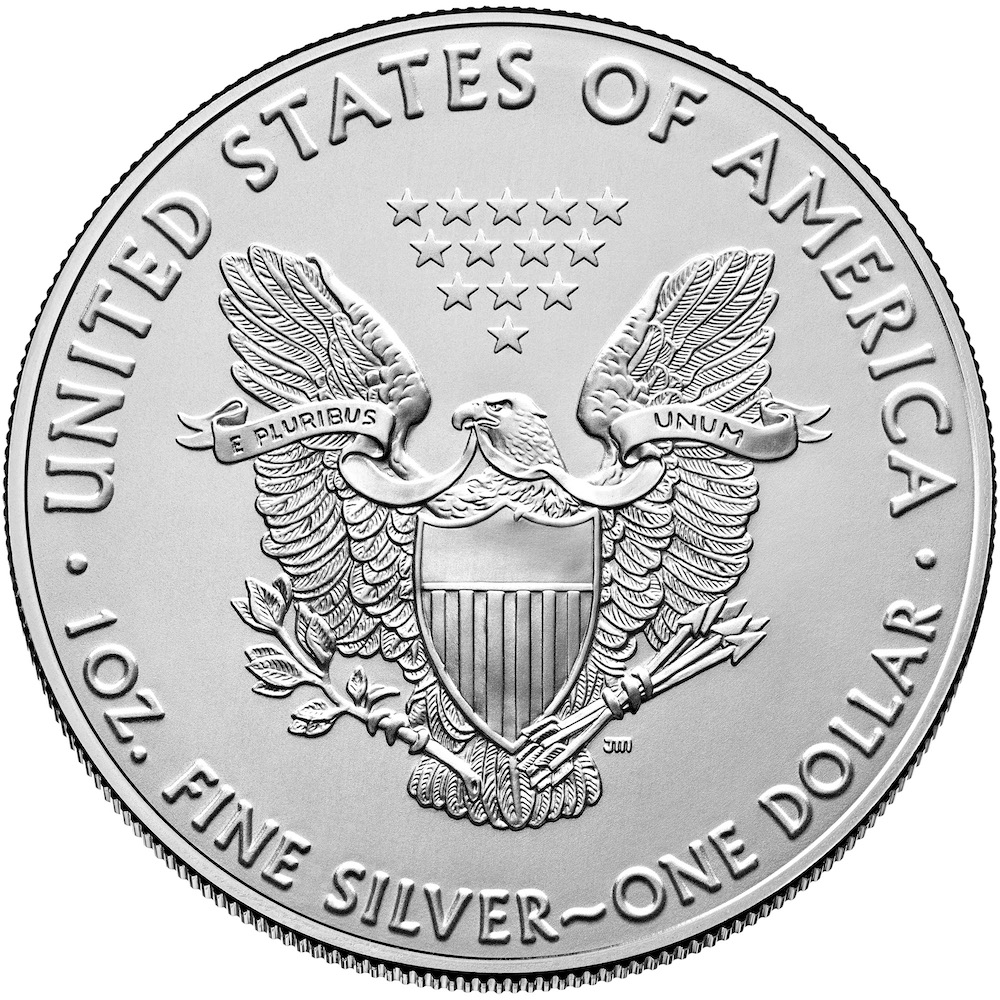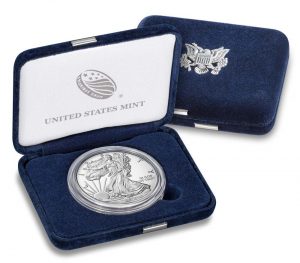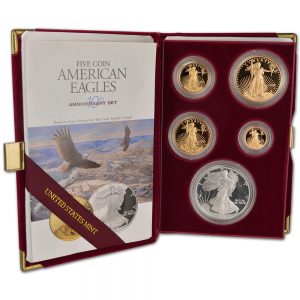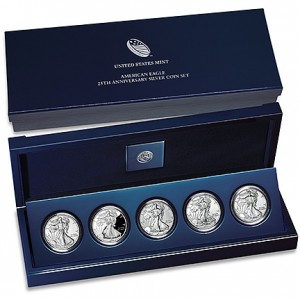Weekly World Numismatic News for February 20, 2022
The news worth reporting is that online scammers are changing how they structure their scams.
After examining the websites reported by several people, they are now:
- The “companies” behind the scams are registered in London, and I am not sure why they chose London.
- Five of the six companies investigated have registrations that point to the owners coming from India. The U.K. and India have had close relations following their independence from the British Empire.
- The websites are hosted in the U.K. using a service that supports online marketplaces.
- After examining a set of coins purchased by a reader, they resemble the counterfeit coins I purchased in 2020.
Many people have talked about doing something to combat counterfeits coming from overseas. Some groups tried to write letters without a response from the recipients. At what point does the numismatic industry stop writing letters and do something?
If the definition of insanity is doing the same thing over and over again, expecting a different outcome, numismatics may be ready to be fitted for a straight jacket.
Since nobody in the numismatic industry is coming up with a plan, I will develop one. It will be comprehensive and involve the entire industry. Give me a few months to research the possibilities.
And now the news…
Weekly World Numismatic News for May 17, 2020

Dennis Rodman with his former agent Dwight Manley (Image courtesy of The Rob Report)
One of the players making an impact of the story early and later is Dennis “The Worm” Rodman. Today, Rodman may be known for his outrageous style and friendship with North Korean leader Kim Jung Un, but when he was playing, Rodman put the term “power” in his position of Power Forward. He started his career with the Detroit Pistons, the Bad Boys of basketball, who dominated the Bulls to win a pair of championships.
Rodman signed with San Antonio as a free agent in 1993 then was traded to Chicago before the 1995-96 season. In Chicago, he went on to win three straight championships.
Throughout Rodman’s journey in the NBA was his friend and agent, Dwight Manley.
The numismatic community knows Manley as a collector and the person who the ANA’s Dwight N. Manley Numismatic Library is named. Among the support that Manley provided to the ANA, he donated the first known illustrated numismatic book printed in 1517.
In a recent interview, Manley spoke about purchasing the Collection of William Spohn Baker that features the finest Washington Medals known to collectors. He said that the ANA would exhibit the medals in 2021. In the future, the medals will likely be in a museum because he feels that the collection should not be broken up.
It may not be easy to impact one area, but Manley can claim he had an impact on sports and numismatics.
And now the news…
 → Read more at robbreport.com
→ Read more at robbreport.com
 → Read more at jpost.com
→ Read more at jpost.com
 → Read more at usmint.gov
→ Read more at usmint.gov
 → Read more at radio.cz
→ Read more at radio.cz
Ancient Coin Online Exhibit

Marcus Claudius Marcellus from the D’Argenio Collection at Seton Hall University
Donated to the university by Ronald D’Argenio (MS’76/JD’79), the collection allows scholars “to trace the relationship of the earliest Roman coins of the Republican period to its immediate Greek predecessors. It includes coins with images of Julius Caesar, the first Roman leader to have his portrait represented on a piece of currency.”
The library added the collections to the Google Arts and Culture online collection. “Google Arts and Culture is a rapidly growing site that displays highlights from over 2,000 museums and private collections. Its app, which can be downloaded from Google Play or the Apple Store, allows the visitor to interact with the artwork through AI features like virtual tours and exhibits.”
The online exhibit is in two parts:
Museum Week and Online Numismatic Collections
 The week of May 11-17, 2020, is supposed to be Museum Week. Museum Week started in 2014 to use social media to promote Galleries, Libraries, Archives, and Museums worldwide. This year, the online festival takes on a new meaning since most museums are closed because of the pandemic.
The week of May 11-17, 2020, is supposed to be Museum Week. Museum Week started in 2014 to use social media to promote Galleries, Libraries, Archives, and Museums worldwide. This year, the online festival takes on a new meaning since most museums are closed because of the pandemic.
Learn more about Museum Week on their website at museum-week.org.
Let’s celebrate Museum Week by the looking at the most extensive numismatic exhibits that has some of their collection online.
National Numismatic Collection at the Smithsonian Institute
 The only way to start this list is with the largest numismatic collection of any type and that is the National Numismatic Collection at the Smithsonian Institute. With over 1.6 million coins, tokens, medals, and other numismatic objects, the collection includes United States, world, and ancient coins. The collection contains rare coins and patterns not seen anywhere else in the world. Amongst its holdings are famous rarities, including all varieties of the 1804 Draped Bust Silver Dollar, a 1913 Liberty Head Nickel, and two 1933 Saint Gaudens $20 Double Eagle coins. Also in the collection is a Brasher Doubloon, sometimes called the United State’s first gold coin, and a 1974 aluminum Lincoln Cent created by the U.S Mint to try to convince Congress to allow for its production.
The only way to start this list is with the largest numismatic collection of any type and that is the National Numismatic Collection at the Smithsonian Institute. With over 1.6 million coins, tokens, medals, and other numismatic objects, the collection includes United States, world, and ancient coins. The collection contains rare coins and patterns not seen anywhere else in the world. Amongst its holdings are famous rarities, including all varieties of the 1804 Draped Bust Silver Dollar, a 1913 Liberty Head Nickel, and two 1933 Saint Gaudens $20 Double Eagle coins. Also in the collection is a Brasher Doubloon, sometimes called the United State’s first gold coin, and a 1974 aluminum Lincoln Cent created by the U.S Mint to try to convince Congress to allow for its production.
When the National Museum of American History reopens, the permanent exhibit is The Value of Money that uses 400 items from the museum’s collection to portray the economic, artistic, and technology of money. Amongst the displays is the famous 1933 Saint-Gaudens Double Eagle, a $100,000 currency note, a personal check signed by James Madison, and a clamshell used to represent one-dollar during the depression.
Edward C. Rochette Money Museum
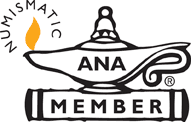 The Edward C. Rochette Money Museum at the American Numismatic Association headquarters in Colorado Springs is the largest museum dedicated to the study of United States coins and currency that also covers the history of numismatics. With over 250,000 pieces, the collections contain famous rare coins, including the George O. Walton specimen 1913 Liberty Head Nickel, an 1804 Draped Bust Silver Dollar, and one of the three known 1866 No Motto Seated Liberty Silver Dollars.
The Edward C. Rochette Money Museum at the American Numismatic Association headquarters in Colorado Springs is the largest museum dedicated to the study of United States coins and currency that also covers the history of numismatics. With over 250,000 pieces, the collections contain famous rare coins, including the George O. Walton specimen 1913 Liberty Head Nickel, an 1804 Draped Bust Silver Dollar, and one of the three known 1866 No Motto Seated Liberty Silver Dollars.
The Rochette Money Museum is the home of the Harry W. Bass, Jr. Collection. Bass was interested in United States gold coins and had built the most complete collection ever assembled, including many one-of-a-kind specimens, of gold coins from 1795 through 1933. Bass’s collection includes the only complete set of $3 gold pieces, including the rare 1870-S, complete set of gold coins and patters from 1834-1933, and a set of 1896 Educational Series silver certificates including test printings and uncut sheets.
The ANA has posted several virtual tours for a good portion of the collection so that it can be seen without going to Colorado Springs. Collectors and ANA members might want to make a trip to visit the museum and the extensive numismatic library when they are allowed to reopen.
Coin and Currency Collections at the University of Notre Dame
 University of Notre Dame Libraries Department of Special Collections boasts one of the largest collections of colonial coins and currencies in the United States. The coin collection includes an Oak Tree one-shilling coin, a Continental dollar, and a 1792 half disme—the first coin-type struck by the newly established United States Mint. The colonial currency collection includes samples from nearly every emission and lottery tickets that were used to raise money to pay the costs of the Revolutionary War. The collection also includes Washington Tokens and Confederate Currency and our Nineteenth-Century American tokens. Visit their online gallery at coins.nd.edu.
University of Notre Dame Libraries Department of Special Collections boasts one of the largest collections of colonial coins and currencies in the United States. The coin collection includes an Oak Tree one-shilling coin, a Continental dollar, and a 1792 half disme—the first coin-type struck by the newly established United States Mint. The colonial currency collection includes samples from nearly every emission and lottery tickets that were used to raise money to pay the costs of the Revolutionary War. The collection also includes Washington Tokens and Confederate Currency and our Nineteenth-Century American tokens. Visit their online gallery at coins.nd.edu.
Penn Museum Archaeology and Anthropology Coin Collection
![]() The University of Pennsylvania Museum of Archaeology and Anthropology has one of the most complete collections of ancient coins. But rather than displaying them as a coin collection, the curators at the museum present the coins with the various theme exhibits. Visit the ancient Roman section, and you can see the coins that defined the rule of the Roman Empire. All coins were found during archaeological visits to the regions of ancient civilizations. To see some of the coins in the collection, you can search their collection.
The University of Pennsylvania Museum of Archaeology and Anthropology has one of the most complete collections of ancient coins. But rather than displaying them as a coin collection, the curators at the museum present the coins with the various theme exhibits. Visit the ancient Roman section, and you can see the coins that defined the rule of the Roman Empire. All coins were found during archaeological visits to the regions of ancient civilizations. To see some of the coins in the collection, you can search their collection.
The Fitzwilliam Museum Coin Collection
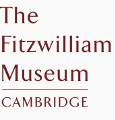 On the campus of Cambridge University, the Fitzwilliam Museum was founded in 1816 when Richard VII bequeathed his art and library holdings to the university. The Fitzwilliam’s Coins & Medals collection has over 200,000 objects including a nearly complete collection of ancient Roman coins issued after the murder of Nero. Amongst its collections are British and other Campaign and Gallantry Medals, European Renaissance medals, unique copper tokens handed out by the Cambridge chandler in 1668, and coins found casually and archaeological discoveries throughout England. The Fitzwilliam boasts of ongoing research into areas such as Indian and Islamic coinage. Visit their online collection Coins & Medals at fitzmuseum.cam.ac.uk.
On the campus of Cambridge University, the Fitzwilliam Museum was founded in 1816 when Richard VII bequeathed his art and library holdings to the university. The Fitzwilliam’s Coins & Medals collection has over 200,000 objects including a nearly complete collection of ancient Roman coins issued after the murder of Nero. Amongst its collections are British and other Campaign and Gallantry Medals, European Renaissance medals, unique copper tokens handed out by the Cambridge chandler in 1668, and coins found casually and archaeological discoveries throughout England. The Fitzwilliam boasts of ongoing research into areas such as Indian and Islamic coinage. Visit their online collection Coins & Medals at fitzmuseum.cam.ac.uk.
Staatliche Museen zu Berlin
 The Coins and Medals collection at the National Museums in Berlin is well known as being very comprehensive and diverse, covering the beginnings of coinage through the coins of today. With over 500,000, it is one of the largest collections in Europe with extensive collections of Greek, Roman, and European coins from the Middle Ages to today. They also have an extensive collection of art medals dating from 1400.
The Coins and Medals collection at the National Museums in Berlin is well known as being very comprehensive and diverse, covering the beginnings of coinage through the coins of today. With over 500,000, it is one of the largest collections in Europe with extensive collections of Greek, Roman, and European coins from the Middle Ages to today. They also have an extensive collection of art medals dating from 1400.
The collection also contains an extensive collection of paper currency primarily from Europe and items used as money from all over the world. The non-coin collection includes tools and dies that were used to strike coins in Berlin since the 17th century.
The Staatliche Museen has one of the most extensive online catalogs of any museum in the world. Museum staff has created a website for users to browse their database of images and descriptions. The online catalog can be found (in English) at www.smb-digital.de.
State Hermitage Museum
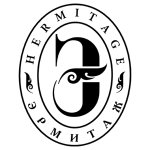 The State Hermitage Museum is located in Saint Petersburg, Russia is one of Europe’s largest museums. Their numismatic collection of over 1.2 million pieces is the most extensive collection known outside of the United States. The largest segment of their collection tracks this history of money in Russia from the ninth century through today.
The State Hermitage Museum is located in Saint Petersburg, Russia is one of Europe’s largest museums. Their numismatic collection of over 1.2 million pieces is the most extensive collection known outside of the United States. The largest segment of their collection tracks this history of money in Russia from the ninth century through today.
The Hermitage Museums’ Oriental collection boasts of coins, money ingots, dies, coin-shaped amulets, and primitive currency of Asia, Africa, and neighboring Atlantic and Pacific islands. The collection includes a collection of very rate Sassanian coins and the 19th-century Chinese silver money ingots that are considered amongst the finest collections in the world. Discover more about their collection on their website at www.hermitagemuseum.org.
Do you know of any others?
A Look at the American Eagles: The American Silver Eagles (UPDATED)
- American Silver Eagles ← you are here
- American Gold Eagles
- American Platinum Eagles
- The New American Palladium Eagles
NOTE: This is an updated article that was first published on September 18, 2018.
After the Coinage Act of 1965 removed silver from United States coinage, the federal government held the silver in the national stockpile. By the 1980s, the supply that far exceeded the needs of the national stockpile. Following several years of discussion that almost led to the bulk auction and sale of the silver, congress decided to use the silver to create a silver investment coin, the American Silver Eagle.
The American Silver Eagle program was so successful that following the depletion of the Defense National Stockpile in 2002, the original law was changed to continue the program by purchasing silver from U.S.-based mines at market prices to be used for future production.
American Silver Eagle Design
The obverse of the coin is the much-beloved design that was used on the Walking Liberty Half-Dollar coin from 1916 to 1947, designed by Adolph A. Weinman, a former student of Augustus Saint-Gaudens. The reverse features a heraldic eagle using a design by John Mercanti. Mercanti engraved both sides of the coin that including copying Weinman’s original design. Mercanti would later become the 12th Chief Engraver of the U.S. Mint.
| American Silver Eagle Specifications | |
|---|---|
| Composition | .999 Fine Silver |
| Weight | One Troy Ounce (31.103 grams) |
| Diameter | 40.6 mm (1.598 inches) |
| Thickness | 2.98 mm (0.1173 inches) |
| Edge | Reeded |
| Face Value | $1.00 |
| Designers | Adolph A. Weinman (obverse), John Mercanti (reverse) |
| Engraver | John Mercanti |
Bullion American Silver Eagle Coins
The American Silver Eagle program produces bullion coins for the investment market and collectible versions of these coins. As bullion coins, the U.S. Mint tries to eliminate the factors that drive the price of collectible coins (mintage, rarity, and condition) by making each coin the same. The U.S. Mint strikes American Silver Eagle to meet the market demand and can be stuck at any branch mint. Bullion coins do not have a mintmark.
The U.S. Mint does not sell bullion coins directly to the public. They sell the coins to “Authorized Purchasers,” who then resell the coins to the market. Although the American Silver Eagle bullion coins are produced for the investment market, some people collect these coins.
As with other investments, American Silver Eagle bullion coins are subject to taxes when sold. Please consult with a financial advisor or tax professional for any tax implications.
Mint of Origin for Bullion Coins
The U.S. Mint branch facility in West Point, New York, has been the primary manufacturer of American Silver Eagle bullion coins. Over the years, the mint facilities in San Francisco and Philadelphia have supplemented production.
Following an investigation, researchers learned that the U.S. Mint struck American Silver Eagle bullion coins at San Francisco and Philadelphia from 2011-2017. Some have tried to use shipping records from the U.S. Mint, shipping labels, packaging materials, and other means to try to investigate the origin of the coins.
In 2015, the industry thought they understand how to tell which Mint struck the coins. According to a statement issued by the U.S. Mint in 2018, the Philadelphia Mint produced 79,640 bullion coins. However, 140 coins were “condemned” and not issued. They shipped 79,500 coins to West Point for distribution to authorized purchasers. Although the boxes contain labels and serial numbers, there was no attempt made to separate the coins by Mint. Further, the U.S. Mint acknowledges that they identified cases of duplicate labels and tracking numbers written on the box. The information creates a reasonable doubt as to determine the manufacturer of the coins.
The third-party grading services believe they identified strike characteristics of the 2015 bullion coins that occurred at the Philadelphia Mint. They have encased American Silver Eagle bullion coins with labels noting their Philadelphia pedigree with no additional evidence.
In 2020, the novel coronavirus (COVID-19) pandemic caused the U.S. Mint branch at West Point to close temporarily. In order to keep up with production, the U.S. Mint struck 240,000 bullion coins in Philadelphia.
The third-party grading services asked the U.S. Mint about the production of these coins. Rather than leave the industry guessing, the U.S. Mint identified which boxes contained American Silver Eagle bullion coins struck in Philadelphia. The grading services are noting the origin of the bullion coin on the label of their slab.
Unlike the 2015(-P) coins, the 2020(-P) coins have an identifiable trail that leaves little doubt to the origin of the coins.
Collector American Silver Eagle Coins
The U.S. Mint produces collector versions of the American Silver Eagle are sold directly to the public in specialty packaging. The U.S. Mint sells American Silver Eagle proof coins in a specially made capsule stored in a blue velvet-covered case in a blue box with a Certificate of Authenticity.
Beginning in 2006, the U.S. Mint has produced an uncirculated business strike coin for the collector market. Most uncirculated American Silver Eagle collector coins are struck in West Point and bear the “W” mintmark. Uncirculated coins are burnished, a process by treating the surface with fine particles to give the surface a smooth, satin finish. The U.S. Mint sells these coins in a capsule with packaging that varies from year to year.
The U.S. Mint has produced coins with reverse proof and enhanced uncirculated finishes. A reverse proof coin is when the elements show a mirror-like appearance and the fields have a matte finish.
In 2009, the U.S. Mint was unprepared for the financial collapse that increased the demand for silver bullion coins. So that the U.S. Mint could produce the coins to meet the investor demand, the U.S. Mint did not produce collector American Silver Eagle coins. Although the American Silver Eagle proof coin returned to the market in 2010, the U.S. Mint did not produce uncirculated burnished coins.
American Silver Eagle collector coins returned in 2011.
OGP vs. GRADED
Collector American Silver Eagle coins can be purchased either in their original government package or graded. When searching for coins that are in their original government packaging on most online auction sites, it is recommended that you add “OGP” as part of the search.
Dealers and collectors will remove the collector American Silver Eagle coins from their original government package in order to submit them to a third-party grading service for grading. Collectors who prefer the encapsulated coins are not concerned with the package. Some dealers will sell the package without the coin for a few dollars, but for collectors of graded coins, this is not a priority.
2007 Reverse Variety
In 2008, the U.S. Mint updated the reverse dies of the American Silver Eagle, giving it a slightly different appearance. The reverse die was only supposed to be used on collector American Silver Eagle coins in 2008 before being used for bullion coins in 2009.
As a result of the human factor required with operating the minting equipment at the West Point Mint, the reverse dies used for the 2007 American Silver Eagle coins were mated with 2008 collector coins creating a new variety for collectors. These coins are known as a 2008-W Silver Eagle Reverse of 2007 Variety.
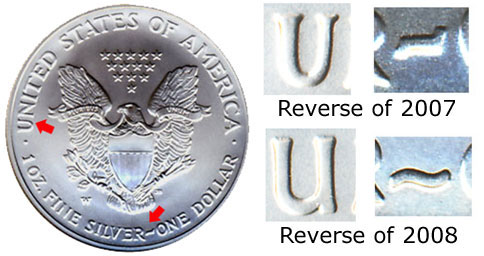
2008-W Silver Eagle Reverse of 2007 Variety
(Image courtesy of the Silver Eagle Guide)
The 1995-W
In 1995, the U.S. Mint created the 10th Anniversary American Eagle set to celebrate the program’s decade. The set contained a 1995-W American Silver Eagle proof coin that was made available only to collectors buying the set. Collectors wanting to add the 1995-W American Silver Eagle proof coin to their collection had to purchase the entire five-coin set that included four American Gold Eagle proof coins ($5, $10, $25, and $50 gold American Eagles). The $999 price for the set helped limit the number of coins sold.
As gold prices have risen, collectors sold the gold coins separately. However, the limited availability has caused the 1995-W American Silver Eagle to rise significantly on the secondary market. Cost to purchase this coin averages about $5,000-6, depending on the grade and finding the entire set with the American Gold Eagle coins in their original government package averages over $8,000.
Special Sets
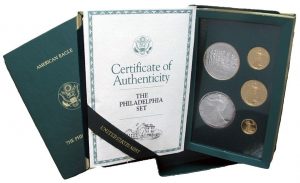 In 1993, the U.S. Mint offered The Philadelphia Set, which was issued to commemorate the 200th Anniversary of the striking of the first official U.S. coins at the Philadelphia Mint. This set included each of the Proof American Gold and Silver Eagles struck at the Philadelphia Mint and containing the “P” mintmark. The set included a 1993-P Proof Silver Eagle along with the one-half ounce, one-quarter ounce, and one-tenth ounce 1993-P Proof Gold Eagles. Also included was a silver Philadelphia Bicentennial Medal, which specially produced for this numismatic product.
In 1993, the U.S. Mint offered The Philadelphia Set, which was issued to commemorate the 200th Anniversary of the striking of the first official U.S. coins at the Philadelphia Mint. This set included each of the Proof American Gold and Silver Eagles struck at the Philadelphia Mint and containing the “P” mintmark. The set included a 1993-P Proof Silver Eagle along with the one-half ounce, one-quarter ounce, and one-tenth ounce 1993-P Proof Gold Eagles. Also included was a silver Philadelphia Bicentennial Medal, which specially produced for this numismatic product.
To mark the launch of the new American Platinum Eagle bullion and collector coin series, the U.S. Mint offered the 1997 Impressions of Liberty Set. This set contained the one ounce 1997-W Proof Platinum Eagle, one ounce 1997-W Proof Gold Eagle, and one ounce 1997-P Proof Silver Eagle. Production was limited to 5,000 individually numbered units. The serial number for each set was engraved on a brass plate affixed to the wooden display case.
In 2004, the U.S. Mint worked with the United Kingdom’s Royal Mint to create a numismatic product containing the silver bullion coins from each country. The Legacies of Freedom Set contained one 2003 American Silver Eagle bullion coin and one 2002 British Silver Britannia bullion coin. The special packaging highlighted the importance of the two national icons.
To celebrate the 150th Anniversary of the founding of the Bureau of Engraving and Printing and the 220th Anniversary of the United States Mint, the two bureaus joined together to release the 2012 Making American History Coin and Currency Set. The set contained a 2012-S American Silver Eagle Proof coin and a $5 note with a serial number beginning in “150.”
As part of the 2016 Ronald Reagan Coin and Chronicles Set the U.S. Mint included a 2016 Proof American Silver Eagle along with a 2016 Ronald Reagan Presidential reverse proof dollar, and a Nancy Reagan Bronze Medal. To complete the set, it included a presidential portrait produced by the Bureau of Engraving and Printing and an informational booklet about President Reagan.
In 2019, the U.S. Mint partnered with the Royal Canadian Mint to issue the Pride of Two Nations silver coin set. The set contained a reverse proof American Silver Eagle struck at West Point and a reverse proof Silver Maple Leaf struck at the Royal Canadian Mint’s facility in Ottawa, Ontario. Production was limited to 100,000 sets in the United States and 10,000 sets in Canada.
Later in 2019, the U.S. Mint released an Enhanced Reverse Proof coin struck at the San Francisco Mint. Its mintage limit of 30,000 coins is less than the number of 1995-W coins issued.
Annual Sets
To extend the product line, the U.S. Mint began to create special annual issue sets to entice people to collect U.S. Mint products. The first annual set containing an American Silver Eagle coin was the Annual Uncirculated Dollar Coin Set. First offered in 2007, the set includes the issued uncirculated Presidential dollar coins, an uncirculated Native American dollar coin, and an uncirculated American Silver Eagle. Since the Presidential Dollar Program ended in 2016, it is unclear whether the U.S. Mint will issue the set in 2017.
Since 2012, the U.S. Mint has been producing the Limited Edition Silver Proof Set that contains 90% silver versions of the year’s five America the Beautiful Quarters, Kennedy Half Dollar, and Roosevelt Dime, along with the standard annual Proof American Silver Eagle. Sets are limited to 50,000 units annually.
Starting in 2013, the U.S. Mint has been producing the Congratulations Set as part of a new line of products targeted towards gift-giving occasions. The set includes the standard annual Proof Silver Eagle within specially designed packaging that allows the gift giver to add a personalized message.
Anniversary Sets
Since the American Eagle Program has been one of the most successful programs in the history of the U.S. Mint, they have used its popularity to extend the product line. Aside from celebrating the anniversary of the program, the U.S. Mint has produced anniversary sets to celebrate Mint facilities.
The Anniversary sets issued are as follows:
- 1995 American Eagle 10th Anniversary Set included a 1995-W American Silver Eagle Proof coin and four American Gold Eagle coins.
- 2006 20th Anniversary American Silver Eagle Set was a special three-coin box set included a 2006-W American Silver Eagle with a burnished (satin) finish, a 2006-W American Silver Eagle Proof coin, and a 2006-P American Silver Eagle Reverse Proof coin.
- 2011 25th Anniversary American Silver Eagle Set was a five-coin box set that contained five different coins. The U.S. Mint produced only 100,000 sets that sold out within the first 10 minutes they were offered online. This extremely popular set is averaging $800 on the secondary market in the original government package. The set includes the following coins:
- 2011-W (West Point) American Silver Eagle Uncirculated coin
- 2011-S (San Francisco) American Silver Eagle Uncirculated coin
- 2011-W (West Point) American Silver Eagle Proof coin
- 2011-P (Philadelphia) American Silver Eagle Reverse Proof coin
- 2011 (no mintmark) American Silver Eagle Bullion coin
- 2012 American Eagle San Francisco Two Coin Silver Proof Set was issued to celebrate the 75th anniversary of the current San Francisco Mint. The set included a 2012-S American Silver Eagle Proof coin and a 2012-S American Silver Eagle Reverse Proof Coin.
- 2013 West Point American Silver Eagle Set was issued to celebrate the 75th anniversary of the facility in West Point, New York. The set included a 2013-W American Silver Eagle Reverse Proof coin and a 2013-W American Silver Eagle Enhanced Uncirculated coin. The set was instantly popular with collectors since it was the first appearance of the Enhanced Uncirculated finishing process.
Although the U.S. Mint did not issue a set to celebrate the 30th Anniversary of the American Silver Eagle in 2016, West Point struck proof and burnished uncirculated collector coins with edge lettering that read “30TH ANNIVERSARY.”
Rolls and the Green Monster Box
Bullion coins are packaged in 20-coin hard plastic rolls with 25 rolls packed in a specially designed green box that contains 500 troy ounces of silver. The U.S. Mint seals the box before shipping them to authorized purchasers. The term Green Monster Box refers to the green box with 500 silver coins.
Resellers sell Green Monster Boxes with the intent of selling to investors. Resellers also sell unopened rolls from the Monster Box.
Sealed Green Monster Boxes have the benefit of being unsearched and unhandled since leaving the U.S. Mint. These boxes are usually offered for sale by bullion dealers at a small premium over the current market (spot) price of silver. Unsealed Monster Boxes with the U.S. Mint’s labels intact can attest to the authenticity of the coins.
In the next installment, we look at the American Gold Eagle coins.
Weekly World Numismatic News for May 10, 2020
This past week, the numismatic world was greeted with the news that the Philidelphia Mint struck a limited number of American Silver Eagle bullion coins to help fill the demand.
Most of the production of the American Silver Eagle bullion coins are in the West Point Mint. Sometimes, the San Francisco and Philadelphia Mints add capacity when necessary, with San Francisco being the priority. Since the West Point and San Francisco Mints temporarily closed because of the effects of COVID-19, Philadelphia picked up the slack.
The U.S. Mint produces all bullion coins without mintmarks. In most cases, it is impossible to tell which mint struck the coins. An exception is the 2015 (P) American Silver Eagles. Collectors and the grading services have been trying to figure out where the green monster boxes came from by examining the serial number and other clues. In 2015, Philadelphia struck just under 80,000 bullion coins. Those handling monster boxes noticed a difference in the packaging and quality.
According to the U.S. Mint, “Monster boxes of 2020 American Eagle Silver Bullion Coins minted in Philadelphia were affixed with a typed label containing the box tracking number; additionally, box tracking numbers were handwritten directly on the boxes. Box tracking numbers 400,000 through and including 400,479 were used on boxes of coins minted in Philadelphia.”
The 480 monster boxes translate into about 240,000 coins.
With that knowledge, the third-party grading services will add a special label noting that the coins were struck at Philidelphia only if the monster box sent for grading has the proper label and seal.
Of course, the price gougers are out in force. Most reputable companies are selling MS-70 graded “emergency” coins at around $250. That is about $200 over a “First Strike” or “Early Release” graded coins. One online seller is offering a pre-sale of the “emergency release” coins in MS-70 PCGS slabs with John Mercanti autographs for $595.
Coins graded MS-69 are selling for $75-80, which is $40-45 over other MS-69 graded coins.
Remember, if the listing says “pre-sale” it means that the seller does not have the coins in inventory.
And now the news…
 → Read more at theweek.co.uk
→ Read more at theweek.co.uk
 → Read more at kitco.com
→ Read more at kitco.com
 → Read more at thevintagenews.com
→ Read more at thevintagenews.com
